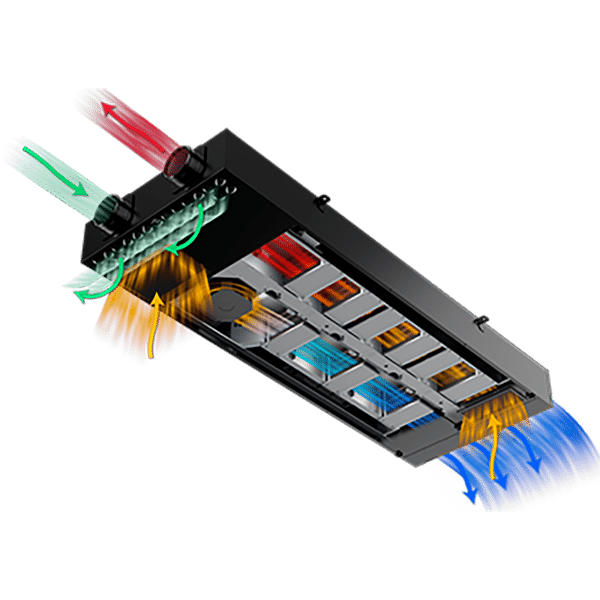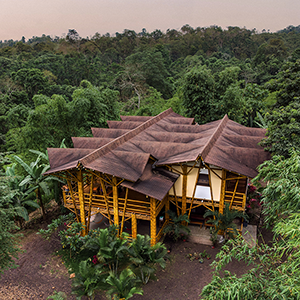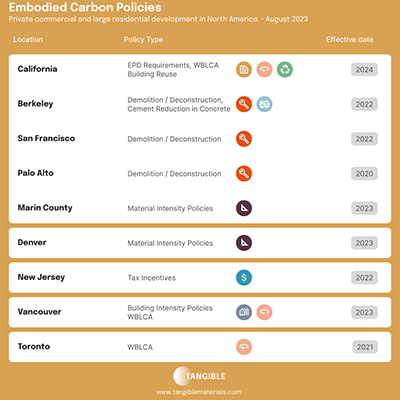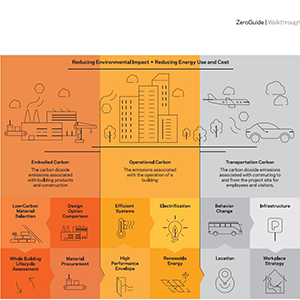Using Life Cycle Assessments to Expand Embodied Carbon Reduction Practices for Buildings and Infrastructure
by Teresa Vangeli and Sarah Buffaloe
As employees of WSP USA — one of the world’s leading engineering and professional services consultancies — and supporters of the Carbon Leadership Forum (CLF), we are excited about the growing interest we’re seeing across our company and our profession to reduce and eliminate the carbon embodied in buildings and infrastructure.
 Of course, we have a long way to go to make reducing embodied carbon a priority that ranks along with safety, function, resilience, aesthetics and other core principles of design and engineering. And we have even further to go to realize the vision of expanding the use of mass timber, plant-based materials, earthen slabs and other innovative strategies to reverse the climate profile of buildings and make them carbon positive.
Of course, we have a long way to go to make reducing embodied carbon a priority that ranks along with safety, function, resilience, aesthetics and other core principles of design and engineering. And we have even further to go to realize the vision of expanding the use of mass timber, plant-based materials, earthen slabs and other innovative strategies to reverse the climate profile of buildings and make them carbon positive.
The new Terminal B project with HOK was a 1.3-million square foot airport addition to the existing airport. The project consisted of a central hall, headhouse, pedestrian bridges, and connections to the garage.

The new Terminal B project with HOK was a 1.3-million square foot airport addition to the existing airport. The project consisted of a central hall, headhouse, pedestrian bridges, and connections to the garage
We are honored to be part of the CLF community where we can connect with other embodied carbon experts and leading practitioners in our industry. It will take considerable collaboration across sectors and disciplines to significantly reduce embodied carbon within the built environment. We find many reasons for optimism within WSP. As we engage with our colleagues around the globe — who now number more than 60,000 — we see increasing understanding of, and commitment to, reducing embodied carbon.
In 2021, WSP USA furthered its commitment to reduce, and ultimately eliminate, embodied carbon in its structural system projects by 2050 as a signatory to the Structural Engineering Institute’s (SEI) SE 2050 Commitment Program. The goal of the SEI program is to coalesce the support of the collective structural engineering industry to drive significant reductions of embodied carbon in the design and construction of structural systems.
It starts with life cycle assessments
WSP’s specialty teams focused on climate, resilience and sustainability have been helping clients measure and reduce life cycle carbon emissions for more than two decades. We conduct rigorous analyses for clients to quantify the embodied carbon and other environmental impacts of their projects and buildings— from data centers and commercial buildings, to transportation infrastructure and multi-family housing.
We are now seeing knowledge and expertise about effective and proven techniques to reduce embodied carbon growing at WSP. For instance, in the critical area of specifying lower-carbon concrete, we’re hearing warnings from our engineering colleagues about the limitations on future supplies of fly ash — a common supplementary cementitious material (SCM) with a favorable carbon profile compared to Portland cement — due to the declining trajectory of coal power plants (sources for the ash) in many regions.
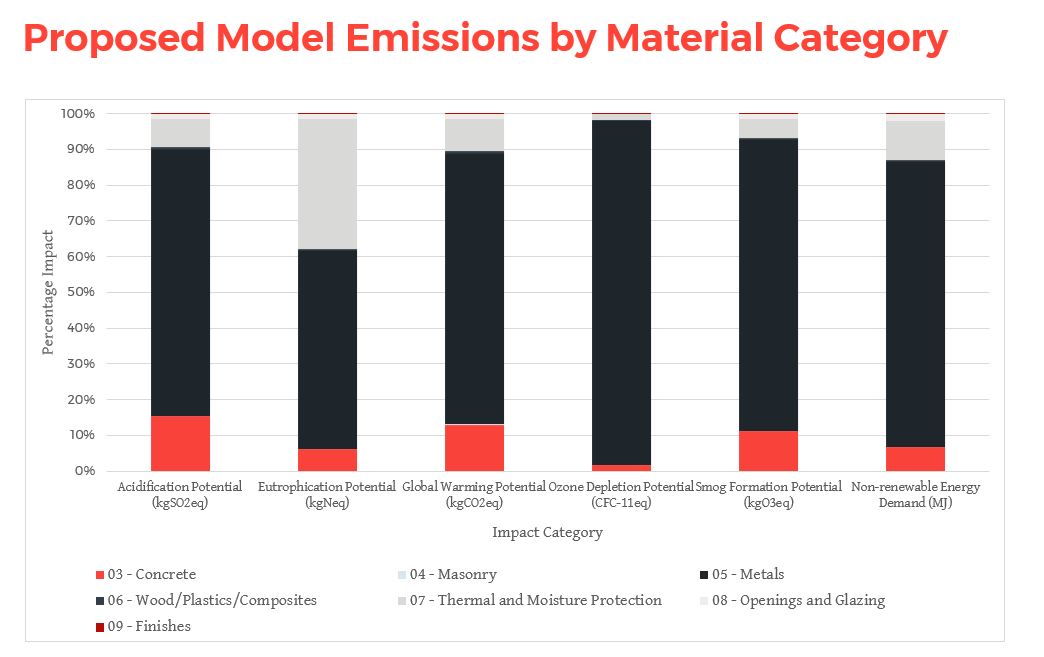
Preliminary results showing the breakdown of which building material category contributes to each embodied impact category. As a steel and concrete building the results show that the majority of impacts come from “metals” which includes structural steel framing, formed metal panels, louvers and rebar.
So, while we celebrate decarbonization in the electric power sector, we’re reminded of the need to explore and develop other new and emerging SCMs, such as limestone, pozzolans and silica fume.
WSP’s commitment to reducing embodied carbon in the built environment means supporting our client’s requests for high-performance projects. The recently completed new Terminal B at La Guardia Airport in New York achieved LEED v4 Gold certification, including a 16 percent reduction in embodied carbon by revisiting the structural design closely with the design team.
Through our involvement in CLF and the SE 2050 Commitment, we are working on an embodied carbon action plan (ECAP) to build capacity among all WSP structural engineers about how to measure and reduce embodied carbon on building and infrastructure projects. We are finding there are fewer tools and guidance available to support measuring and reducing carbon in infrastructure projects compared to buildings.
Learning from our colleagues
As a global company, we are able to learn from our WSP colleagues around the world. Last year WSP UK made a bold commitment to halve the carbon emissions from their designs and advice by 2030 (they’ve now been joined by WSP Sweden, WSP Denmark and WSP New Zealand). To support this commitment, our UK colleagues have been developing methodologies and tools to estimate carbon emissions from the many types of projects that we support. As we develop our ECAP for WSP USA, we can leverage the great work being done across the pond.
We’re also seeing significant generational change. Engineers who are recent graduates are bringing with them a higher level of awareness about what needs to be done for sustainability and resilience in the built environment. Sustainability is now integrated into the standard engineering curriculum. As their idealism meets the experience of senior engineers, and as embodied carbon becomes a greater concern for public and private project sponsors, we think we’ll see a flowering of new ideas and solutions and continued maturing of the embodied carbon accounting methods championed by CLF.
Author Bios
Sarah Buffaloe is an associate for Built Ecology at WSP USA. She joined the firm in November 2014 and resides in Washington, D.C. She applies holistic thinking and quantified metrics to implement solutions that address the wide range of performance goals every project faces. Her five years specializing in sustainable materials at the U.S. Green Building Council, combined with her three years of architectural design experience and academic pursuits in material research and LCA, give her a unique perspective on building materials and their life cycle and durability.
Teresa Vangeli is a director of structures and sustainability at WSP USA. She resides in the Boston area. Vangeli is passionate about bringing sustainable design integration into building and infrastructure design. As a licensed professional engineer, structural discipline, project manager, Envision verifier and LEED AP, she encourages all engineers to get involved in sustainability. She has worked on all types of projects from airport facilities to tunnels to development masterplans across the United States. Vangeli feels that every project can be more sustainable.
Authors

Sarah Buffaloe
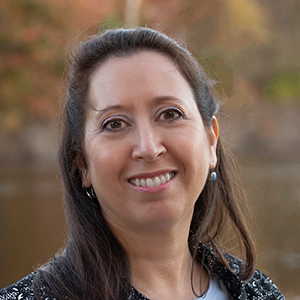
Teresa Vangeli

